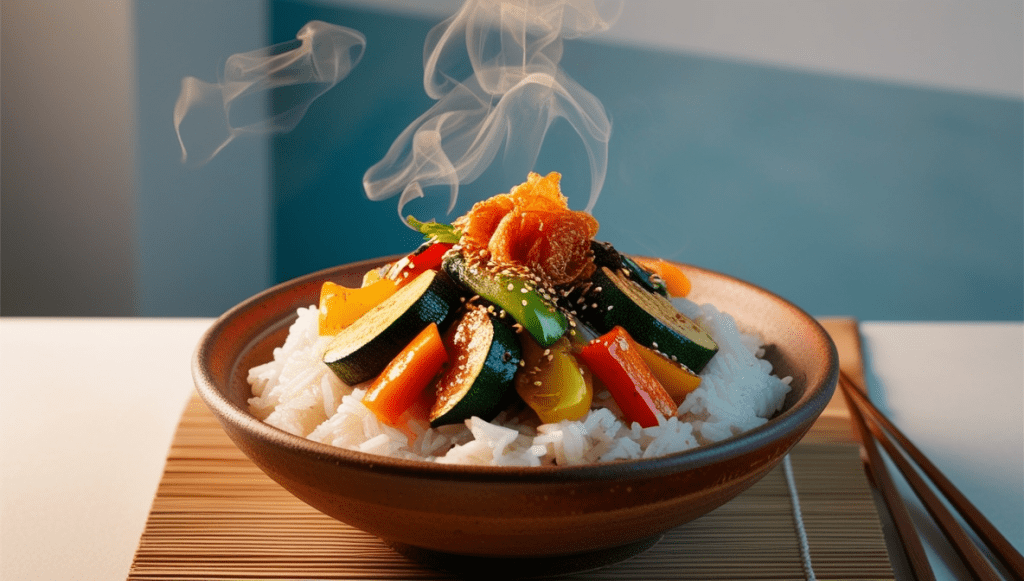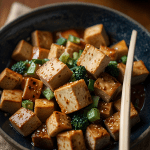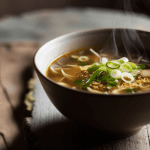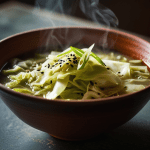
Bibimbap is a traditional Korean dish that translates to “mixed rice.” It’s a colorful and nutritious meal that features a base of rice topped with an assortment of sautéed vegetables, a fried egg, and gochujang (Korean chili paste). This dish is not only visually appealing but also offers a delightful combination of flavors and textures. Below is a detailed recipe for making delicious bibimbap at home.
Ingredients
For the Bibimbap:
- 4 cups cooked short-grain rice (white or brown)
- 1 cup spinach, blanched and squeezed dry
- 1 cup bean sprouts, blanched
- 1 large carrot, julienned
- 1 zucchini, julienned
- 1 red bell pepper, sliced
- 4 shiitake mushrooms, sliced (optional)
- 4 eggs (sunny-side up or fried)
- 2 tablespoons vegetable oil (for sautéing)
- Sesame seeds (for garnish)
- Salt to taste
For the Gochujang Sauce:
- 4 tablespoons gochujang (Korean chili paste)
- 2 tablespoons sesame oil
- 1 tablespoon sugar
- 1 tablespoon rice vinegar
- 1 teaspoon minced garlic
Instructions
Prepare the Rice: Cook your short-grain rice according to package instructions. Once cooked, set aside and keep warm.
Prepare the Vegetables:
- In a skillet, heat 1 tablespoon of vegetable oil over medium heat. Add the carrots and sauté for about 2 minutes until slightly softened. Season with salt and remove from the skillet.
- In the same skillet, add another tablespoon of oil and sauté the zucchini for 2 minutes until tender. Remove from the skillet.
- Sauté the spinach briefly until wilted, then season with a pinch of salt.
- If using mushrooms, sauté them in the same skillet until cooked through.
Prepare the Gochujang Sauce: In a small bowl, mix together gochujang, sesame oil, sugar, rice vinegar, and minced garlic until well combined. Adjust to taste.
Fry the Eggs: In a separate pan, fry the eggs sunny-side up or to your desired doneness.
Assemble the Bibimbap:
- In each serving bowl, place a generous scoop of warm rice.
- Arrange the sautéed vegetables (carrots, zucchini, spinach, bean sprouts, bell pepper, and mushrooms) in sections on top of the rice.
- Place a fried egg in the center of each bowl.
- Drizzle with gochujang sauce and sprinkle with sesame seeds.
Serve: Serve immediately while hot. To eat, mix all components together in the bowl to combine flavors before enjoying!
Tips for Making Great Bibimbap
- Customize Your Vegetables: Feel free to use any vegetables you have on hand. Common additions include radishes, corn, or even kimchi for extra flavor.
- Protein Options: For a heartier meal, you can add marinated beef (yukhoe), chicken, or tofu as additional toppings.
- Make It Vegan: Skip the egg or replace it with scrambled tofu for a vegan version.
What Are the Best Vegetables to Use in Bibimbap?
Bibimbap is known for its colorful array of vegetables, which not only add flavor but also nutrition. Here are some of the best vegetables to include:
- Spinach: Blanched and seasoned with sesame oil and garlic.
- Bean Sprouts: Lightly blanched for crunch.
- Carrots: Julienne or shredded, sautéed until slightly tender.
- Zucchini: Sliced into matchsticks and lightly sautéed.
- Mushrooms: Shiitake or button mushrooms sautéed for umami flavor.
- Cucumber: Thinly sliced and can be marinated for extra flavor.
- Red or Yellow Bell Peppers: Sliced and sautéed or raw for sweetness.
- Radishes or Daikon: Adds a crisp texture and peppery flavor.
Feel free to customize your bibimbap with any seasonal vegetables you enjoy!
How Do You Make Gochujang Sauce from Scratch?
Making gochujang sauce at home is simple and allows you to adjust the flavors to your preference. Here’s a basic recipe:
Ingredients
- 4 tablespoons gochujang (Korean chili paste)
- 2 tablespoons sesame oil
- 1 tablespoon sugar (or honey)
- 1 tablespoon rice vinegar
- 1 teaspoon minced garlic
Instructions
- In a small bowl, combine all ingredients.
- Mix well until smooth and fully integrated.
- Adjust sweetness or spiciness by adding more sugar or gochujang as desired.
This sauce can be drizzled over your bibimbap or served on the side.
Can I Substitute the Gochujang Sauce with Another Ingredient?
If you don’t have gochujang, you can substitute it with:
- Sriracha: Offers similar heat but lacks the fermented flavor; mix with a bit of miso paste for depth.
- Chili Garlic Sauce: Provides heat and garlic flavor but will be less sweet.
- Homemade Blend: Combine red pepper flakes with soy sauce and a touch of sugar to mimic the sweet-spicy profile.
What Type of Rice Is Best for Bibimbap?
The best rice for bibimbap is short-grain white rice, which is sticky and holds together well when mixed with other ingredients. Brown rice can be used for a healthier option, adding more fiber and nutrients. Some people also enjoy using cauliflower rice for a low-carb alternative.
How Do You Cook the Perfect Sunny-Side-Up Egg for Bibimbap?
To achieve the perfect sunny-side-up egg:
- Heat a Non-Stick Pan: Use medium-low heat to prevent burning.
- Add Oil: A small amount of vegetable oil or butter will help prevent sticking.
- Crack the Egg: Gently crack the egg into the pan without breaking the yolk.
- Cook Slowly: Allow it to cook undisturbed until the whites are set but the yolk remains runny (about 2-3 minutes).
- Cover (Optional): If you want to cook the top of the egg slightly, cover it with a lid for 30 seconds.
This method ensures that your egg has a beautifully runny yolk that mixes well with the other ingredients in bibimbap.
Calories in Korean Bibimbap: A Nutrient-Packed Meal Guide
Bibimbap, one of Korea’s most beloved dishes, is a vibrant and nutritious bowl of mixed rice, vegetables, protein, and spicy sauce. Known for its balanced flavors and colorful presentation, bibimbap offers a hearty meal that’s also rich in nutrients. But if you’re curious about its caloric content—especially for health-conscious eaters—let’s break down the calories in a typical bibimbap bowl and examine some variations and health benefits.
What is Bibimbap?
Bibimbap (literally meaning “mixed rice”) is a classic Korean dish featuring rice topped with an assortment of sautéed vegetables, a choice of protein (such as beef, chicken, or tofu), and a dollop of spicy gochujang (Korean red chili paste). Often served in a hot stone bowl (dolsot), bibimbap is mixed just before eating, resulting in a beautiful fusion of flavors and textures.
Key Ingredients in Bibimbap
The core components of bibimbap contribute to its unique flavor and nutritional profile. Here are some common ingredients found in a traditional bibimbap bowl:
- White or Brown Rice: The base of bibimbap, rice provides carbohydrates and calories for energy.
- Vegetables: Carrots, spinach, bean sprouts, mushrooms, zucchini, and cucumbers add fiber, vitamins, and minerals.
- Protein: Beef is commonly used, but tofu, chicken, or even a fried egg can serve as a protein source.
- Gochujang: This spicy, slightly sweet chili paste adds flavor and a modest number of calories.
- Sesame Oil: A small amount of sesame oil is usually drizzled over the bowl, enhancing flavor and providing healthy fats.
Caloric Breakdown of Traditional Bibimbap
The calorie count in bibimbap can vary widely based on portion size and the specific ingredients used. Below is an approximate caloric breakdown for a standard serving (about 550-600g) of bibimbap:
| Ingredient | Estimated Calories (per serving) |
|---|---|
| White rice (1 cup cooked) | ~200-250 calories |
| Mixed vegetables | ~100-150 calories |
| Beef (3 oz cooked) | ~150-200 calories |
| Gochujang (1 tbsp) | ~35 calories |
| Sesame oil (1 tsp) | ~45 calories |
| Total | 530-680 calories |
These numbers can serve as a general guideline, though actual calorie counts may vary based on preparation methods, portion sizes, and optional ingredients.
Lower-Calorie Alternatives for Bibimbap
If you’re aiming to reduce the calorie content of your bibimbap without sacrificing flavor, here are some simple substitutions:
- Use Brown Rice or Cauliflower Rice: Swapping white rice for brown rice increases fiber, which aids in digestion and can make you feel fuller with fewer calories. Alternatively, using cauliflower rice can cut down significantly on carbohydrates and calories.
- Lean Protein Options: Try using tofu, chicken breast, or shrimp instead of beef to lower the calorie count while still getting a good amount of protein.
- Limit Oil Usage: Reduce or skip sesame oil, or use it sparingly, as oils can add hidden calories quickly.
- Opt for Less Gochujang: While gochujang adds depth to bibimbap, it can contain sugars. Use it in moderation or try a low-calorie, homemade version if you’re watching your sugar intake.
Calories in Different Types of Bibimbap
Bibimbap can vary widely depending on the specific ingredients and cooking methods used. Here are some popular variations and their estimated calorie counts:
- Vegetarian Bibimbap: Often made with tofu or extra vegetables, vegetarian bibimbap can be around 450-500 calories per serving, especially if using a minimal amount of oil.
- Chicken Bibimbap: Using grilled or stir-fried chicken instead of beef can lower the calorie count to around 500-550 calories per serving.
- Dolsot Bibimbap: Bibimbap served in a hot stone bowl often includes a crispy layer of rice at the bottom due to the high heat, adding a bit more oil and calories. Expect dolsot bibimbap to be around 600-700 calories depending on how much oil is used.
- Seafood Bibimbap: Adding shrimp, squid, or fish to bibimbap can make a deliciously light version, usually ranging from 480-540 calories per bowl.
Nutritional Benefits of Bibimbap
While calorie-conscious eaters may focus on numbers, it’s also worth noting that bibimbap offers an array of nutrients that contribute to a well-rounded diet:
- High Fiber Content: The mix of vegetables and rice provides fiber, aiding in digestion and promoting feelings of fullness.
- Rich in Vitamins and Minerals: Vegetables like carrots, spinach, and mushrooms deliver vitamins A, C, and K, as well as essential minerals like potassium and iron.
- Protein-Packed: Whether from beef, tofu, or a fried egg, bibimbap includes a healthy dose of protein that helps with muscle repair and satiety.
- Healthy Fats: Sesame oil and the small amount of fat from protein contribute beneficial unsaturated fats, which support heart health and improve nutrient absorption.
Frequently Asked Questions
- Is Bibimbap Good for Weight Loss?
Yes, bibimbap can be part of a weight-loss diet due to its balanced nutrients and customizable ingredients. Choosing brown rice, lean protein, and minimal oil can help keep the calories low while providing a satisfying meal. - How Can I Make Bibimbap Gluten-Free?
Bibimbap is generally gluten-free, but double-check that your gochujang and any seasonings do not contain wheat-based ingredients. Some gochujang brands may include gluten, so look for a certified gluten-free option if necessary. - How Many Calories are in Instant Bibimbap?
Instant bibimbap options, available in many Korean grocery stores, tend to be around 400-500 calories per serving. Keep in mind that they may be higher in sodium due to added flavor enhancers. - Is Bibimbap Vegan?
Traditional bibimbap often includes egg and meat, but you can easily make a vegan version by skipping these and using tofu or additional vegetables. Vegan bibimbap is typically lower in calories (around 400-450 calories) and still nutrient-rich.
Bibimbap is a balanced, colorful, and satisfying meal that fits into many dietary preferences and nutritional goals. Whether you’re enjoying a classic beef bibimbap or opting for a lighter, plant-based version, you can tailor this dish to fit your caloric and dietary needs. Keep in mind that the ingredients you choose will impact the final calorie count, so adjusting the toppings, proteins, and oils can help you create a bowl that aligns with your health objectives while still indulging in the delicious flavors of Korean cuisine.
Enjoy experimenting with different combinations and flavors to make bibimbap your own!
Bibimbap is not only delicious but also highly customizable to suit your taste preferences. With its vibrant colors and variety of textures, this dish is perfect for any occasion—whether it’s a weeknight dinner or a special gathering. Enjoy creating your own bibimbap masterpiece at home!











